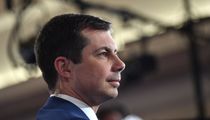Sen. Bernie Sanders (I-Vt.) on Monday rolled out a plan under which the federal government would make child care and pre-kindergarten available to all American families, with no tuition or fees.
The Sanders plan, which campaign officials provided to reporters over the weekend, is the latest major proposal on early childhood to come from a 2020 Democratic presidential candidate. And with a projected budget of $1.5 trillion over 10 years, the Sanders plan may also be the biggest.
Child care has gotten more attention than ever in this presidential campaign, in part because so many families are struggling to find it. Child care can cost more than college tuition in some parts of the country, while even well-off families can struggle to find providers that offer safe, quality care.
Sen Elizabeth Warren (D-Mass.) introduced a sweeping child care plan more than a year ago, while former South Bend, Indiana, Mayor Pete Buttigieg rolled out his proposal in December.
Sanders has his own extensive record of advocacy on this issue. He has long backed universal child care in principle, invoking the idea in his stump speeches and debate performances. But this new proposal represents the first time he has sketched out exactly how he would like to see such a program work in practice.
Under the Sanders plan, the federal government would provide that $1.5 trillion to states, who in turn would create and maintain their own networks of child care centers that meet federal standards on adult-to-child ratios and other quality measures.
The assumption is that most states would start by financing and expanding the child care services that are already available, whether through small, independent providers or larger ones affiliated with organizations like the YMCA. Home-based providers could also be part of the program.
But the Sanders plan also includes funding to underwrite the construction of new facilities, especially when it comes to increasing capacity for pre-kindergarten ― that is, for kids in the year or two before kindergarten starts ― on the theory that states will frequently choose to do so through their public school systems.
Indeed, a major theme of the Sanders proposal is to treat child care as an extension of public education.
That means, among other things, focusing on raising qualifications and pay for the adults who care for children. Following a phase-in period, child care providers would have to meet the same training standards they do for the federal Head Start program, in which, for example, all lead preschool teachers must have a bachelor’s degree in early childhood education or some related field.
In return, the program envisions paying child care providers more like public school teachers by requiring that they make a living wage. Although the plan does not specify what that means, it’s bound to be a lot higher than existing wages, which are about $12 an hour or roughly the median wage for retail cashiers. Those low wages make it difficult to attract or retain the most talented workers.
The other way the Sanders plan treats child care like public education is by making it free at the point of service. It would be open to all families, regardless of income, at no direct cost to them.
This is also the most conspicuous difference between the plan from Sanders and the plans from other Democrats, especially Warren.
Child care has become something of a signature issue for Warren. She emphasizes her plan in campaign appearances, frequently referencing her own experiences as a working mother who struggled to find care for her kids.
But while the Warren and Sanders plans have a lot in common, including the emphasis on quality, hers would guarantee free child care only for families with incomes of up to twice the poverty line, which works out to about $52,000 a year for a family of four.
For families making more than that, child care would require fees, albeit on a sliding scale pegged to income and with a guarantee that no family would have to pay more than 7% of its income on child care.
This is the same basic approach in the Buttigieg plan and on Capitol Hill, in legislation introduced by Sen. Patty Murray (D-Wash.) and Rep. Bobby Scott (D-Va.).
That decision to make child care free for all, rather than free for just lower income families, reflects Sanders’ long-standing commitment to full universality ― the idea that programs are most resilient, most equitable and, ultimately, most effective when they are available to all people under the same conditions.
But that decision also means the federal government would have to spend more money on the program. And that money would have to come from somewhere.
The Sanders campaign says that it can finance the entire initiative by using money from its proposed wealth tax that it has not yet allocated for other purposes. It also points out that investments in early childhood can pay off over the long run, because, according to a large body of research, kids who get high quality care tend to be healthier and more successful later in life.
"plan" - Google News
February 24, 2020 at 06:00PM
https://ift.tt/3a42beb
Bernie Sanders Rolls Out $1.5 Trillion Plan For Free, Universal Child Care - HuffPost
"plan" - Google News
https://ift.tt/2un5VYV
Shoes Man Tutorial
Pos News Update
Meme Update
Korean Entertainment News
Japan News Update
Bagikan Berita Ini

















0 Response to "Bernie Sanders Rolls Out $1.5 Trillion Plan For Free, Universal Child Care - HuffPost"
Post a Comment